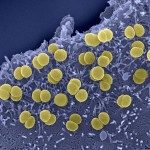Link to Pubmed [PMID] – 12757952
FEMS Microbiol Lett 2003 May; 222(1): 99-106
We developed a model of sequential influenza A virus (IAV)-Neisseria meningitidis serogroup C (Nm) infection in BALB/c mice. Mice infected intranasally with a sublethal IAV dose (260 pfu) were superinfected intranasally with Nm. Fatal meningococcal pneumonia and bacteremia were observed in IAV-infected mice superinfected with Nm on day 7, but not in those superinfected on day 10. The susceptibility of mice to Nm superinfection was correlated with the peak interferon-gamma production in the lungs and decrease in IAV load. After Nm challenge, both IAV-infected and uninfected control mice produced the inflammatory cytokines interleukin (IL)-1 and IL-6. However, IL-10 was detected in susceptible mice superinfected on day 7 after IAV infection, but not in resistant mice. This model of dual IAV-Nm infection was also used to evaluate the role of bacterial virulence factors in the synthesis of the capsule. A capsule-defective mutant was cleared from the lungs, whereas a mutant inactivated for the crgA gene, negatively regulating expression of the pili and capsule, upon contact with host cells, retained invasiveness. Therefore, this model of meningococcal disease in adult mice reproduces the pathogenesis of human meningococcemia with fatal sepsis, and is useful for analyzing known or new genes identified in genomic studies.


